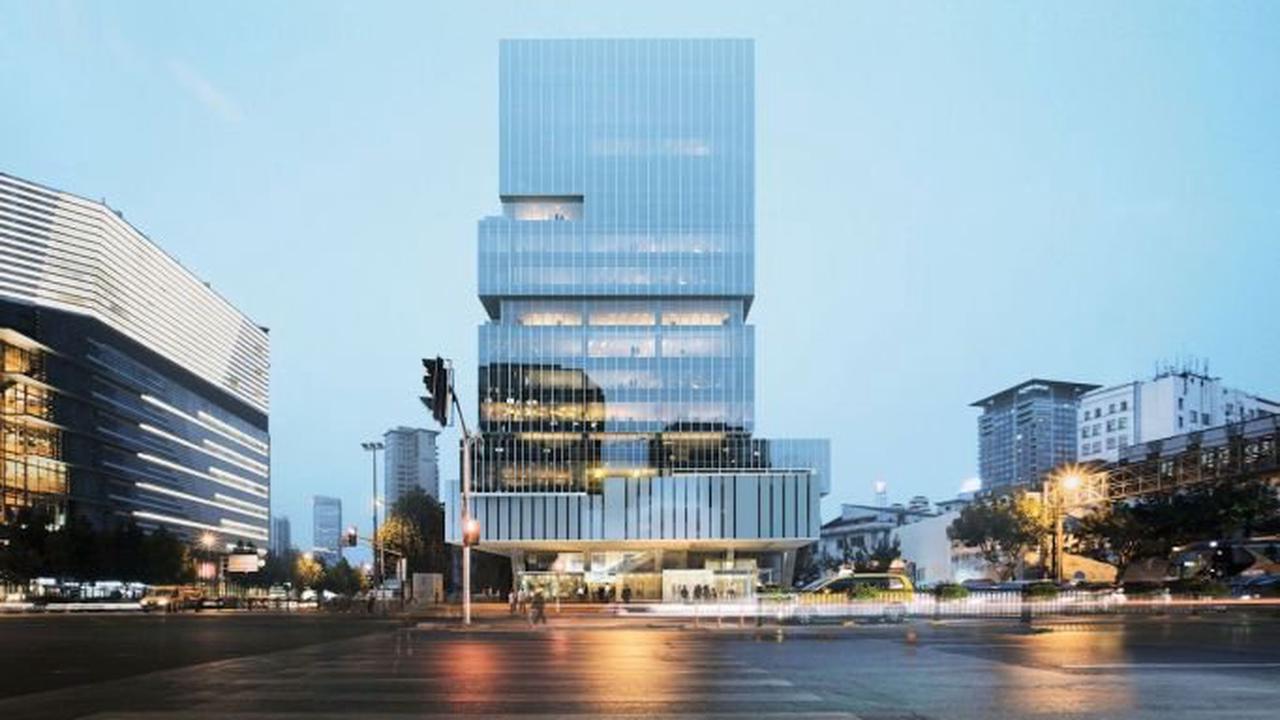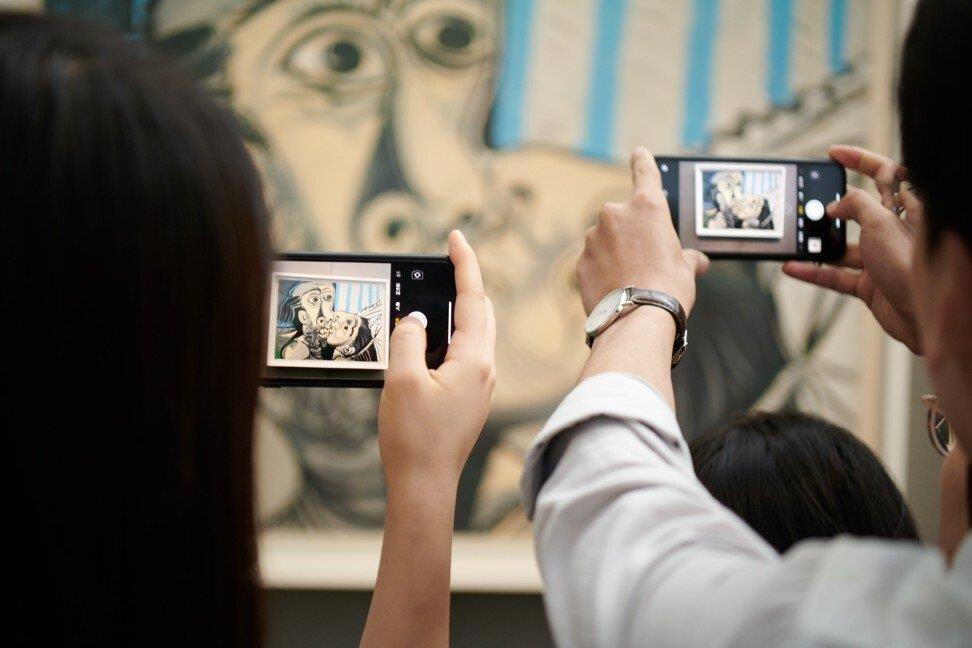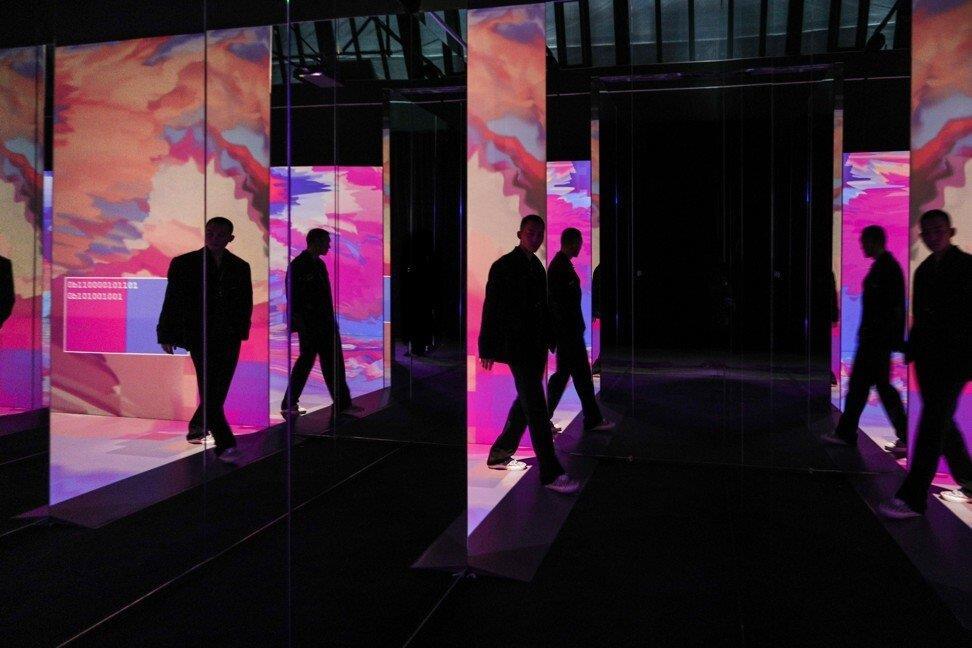
The Beijing-based UCCA Center for Contemporary Art opened a hotly anticipated Shanghai outpost
(MENAFN- USA Art News) The opening this week of a Shanghai branch of the UCCA Centre for Contemporary Art (UCCA) marks the most significant expansion of the Beijing cultural institution since its founding in 2007.
The non-profit art centre already has one satellite branch. The surrealist UCCA Dune opened in the northern resort town of Beidaihe in 2018, a series of conceptual buildings seemingly sitting inside a sand dune. But Shanghai is mainland China's biggest and most international art hub, and the UCCA Edge, which occupies three floors of a new commercial building, is an eagerly awaited addition to a downtown contemporary arts cluster that comprises the Oct Contemporary Art Terminal, Museum of Contemporary Art Shanghai, Rockbund Art Museum and galleries along the Bund.
Overseeing the opening is Philadelphia-born Philip Tinari, the director of UCCA since 2011 (and, concurrently, the chief executive officer since 2017). A fluent Chinese speaker, he has been the public face of UCCA, one of few privately held art centres in China and known for its rigorous and professional curatorial team. His presence has helped the centre project a sense of continuity, Belgian collector Guy Ullens..
The 41-year-old says he is excited UCCA can now reach a broader audience in Shanghai. 'In Beijing, you still have a very high concentration of artists, curators, critics, foreign media and intellectuals, a kind of specialist public. In Shanghai there's this broad urban culture of cultural consumption,' he says.
In 2018, UCCA opened its second museum, Dune, in Beidaihe in China's Hebei province. Photo: UCCA UCCA Edge's inaugural show, called 'City on the Edge: Art and Shanghai at the Turn of the Millennium', will trace how the city came to be at the forefront of Chinese contemporary art, as host to major international art fairs and some of China's most well-established private museums, such as the Long Museum and Yuz Museum. 'The show explores moments [like] the 1980s or turn of the millennium. It gives a sense of what art and Shanghai felt like at [those specific moments] when Chinese contemporary art [went global],' Tinari says.
'Through the 1990s, you had Chinese artists participating in shows in Europe, the US, Hong Kong and wherever else. But it's not until 2000 with the Shanghai Biennale that larger transitions [come with] the arrival of commercial galleries and art districts. Suddenly there was a global art world inside China.'
The show features the work of more than 20 Chinese and overseas artists, including Matthew Barney from the US and South African William Kentridge.There will also be a sculptural work, Bank of Sand, Sand of Bank (2000), made by Fujian native Huang Yongping for the 2000 Shanghai Biennale.

The UCCA Centre for Contemporary Art's third location, UCCA Edge in Shanghai, opens this week in a new commercial building in the city's downtown. Photo: UCCA 'Huang, who spent most of his life in Paris, passed away in 2019. In the form of a sandcastle, the piece is a model of the HSBC building on the Bund. The site of the Biennale, Shanghai Art Museum was formerly the clubhouse building of the Shanghai Race Club, which was built in 1934. Sandcastles imply fragility and impermanence. It is a key piece for Shanghai at that moment,' Tinari says.
Incidentally, Huang's sandcastle artwork was featured on the cover of the first issue of bilingual art magazine LEAP, founded in Beijing by Tinari in 2009.
An upcoming exhibition at UCCA Edge, 'Becoming Andy Warhol', running from July to October, will feature 300 works on loan from the Andy Warhol Museum in Pittsburgh.
UCCA Edge's upcoming show 'Becoming Andy Warhol' will run from July to October at the Edge, and will feature 300 works on loan from the Andy Warhol Museum in Pittsburgh, US. Photo: UCCA Staging shows by big-name artists has become a focus of UCCA since its sale in 2017. Its 2019 exhibition 'Picasso – Birth of a Genius', featuring 103 of Pablo Picasso's works on loan from the Musée National Picasso-Paris, attracted nearly 400,000 visitors.
Tinari says all shows, whether by renowned or lesser-known artists, are equally important. 'When people come to see Warhol, they will also see a solo show of a young Chinese artist about his home in Changchun,' he says.
UCCA was established in 2007 as the Ullens Centre for Contemporary Art by Guy and Myriam Ullens from Belgium. Guy Ullens, a former diplomat, and his wife devoted themselves to philanthropy after he left the business world in 2000. While they are credited with making contemporary Chinese art global through UCCA, for profiting hugely from contemporary Chinese art sales after helping to make artists international stars.
Government funding has never been a major source of support for us. We've never had an endowment that produces steady operating funds every year.Philip Tinari, CEO of the UCCA Centre for Contemporary ArtAccording to a 2017 article on zxart.cn, the couple began selling art they had accumulated at auctions in 2009. In 2011, Zhang Xiaogang's painting Eternal Love (1988) sold for US$10.1 million at Sotheby's. Zeng Fanzhi's The Last Supper (2001) fetched US$23 million in 2013, also at Sotheby's.
After another mega sale at Poly International in Hong Kong in 2017, a year after Ullens announced plans to sell the UCCA, Fei Dawei, the founding director of UCCA and the head of the Ullens Art Foundation from 2002 to 2008, called the sale 'shameless' in a post on WeChat.Fei noted that many artists had sold their works to Ullens at low prices and that the foundation had said it would not sell its legacy. 'The worst evil in the world is to manipulate others' kindness,' Fei said on WeChat.
Tinari said he does not talk about Ullens generally, other than to say: 'We're extremely proud of the way UCCA has grown from that early moment to what it represents today'.
He declined to answer questions about the promotion of art in China's current political climate, or to address accusations of self-censorship – Ai's name was dropped from a press release announcing a 2014 UCCA tribute show to Dutch-born and Beijing-based curator Hans van Dijk, who co-founded experimental gallery China Art Archive and Warehouse with Ai in 1998. Ai subsequently pulled three of his works from the show.

Xu Bing (right) was the first major Chinese artist Philip Tinari met, when Xu travelled to Duke University in the US for a stint as visiting professor two decades ago. When UCCA opened in 2007, it operated as a business because the legal framework for running non-profit art foundations in China was incomplete. In 2018, UCCA registered as a Chinese non-profit, something Tinari says was a real milestone. Its new status brought UCCA into line with other private art museums overseas that are operated by foundations.
'The [Chinese government] policy around art museums has become much more mature. When we first opened, it was unknown territory,' he says.

In 2019, UCCA's Birth of a Genius show of 103 of Picasso's works on loan from the Musée National Picasso-Paris attracted nearly 400,000 people. Photo: UCCA While he would not discuss its budget, Tinari says UCCA has become more financially stable by generating revenue through multiple avenues, including educational activities, retailing, ticketing and corporate sponsorship.
'Government funding has never been a major source of support for us. We've never had an endowment that produces steady operating funds every year. Two years ago, we launched the Young Associates, a very entry-level kind of patronage programme. The annual contribution is 20,000 yuan (US$3,100). We have 150 members [so far],' says Tinari.
Another major source of revenue is UCCA Lab, which took over the work of UCCA's special projects arm launched in 2012. 'In the old model of exhibition sponsorship, the brands just want to have their logos at the entrance. But [nowadays], it's more often a collaboration,' he says.

Immaterial / Re-material: A Brief History of Computing Art was shown at UCCA in 2020. Photo: UCCA
The Lab's biggest project last year was with Chinese internet company Baidu for a show called 'Immaterial / Re-material: A Brief History of Computing Art'. Baidu sponsored it and created the exhibition with UCCA's expertise to show off its AI technology.
Other brands to have collaborated with UCCA include Dior, Adidas and Disney.
In February 2020 at the peak of the Covid-19 pandemic in China, UCCA collaborated with short-video platform Kuaishou on an online concert featuring 39 musicians from around the world, including Ryuichi Sakamoto.
Like art museums around the world which were forced to close and organise virtual shows, Tinari says the pandemic made UCCA embrace innovation and versatility in the face of difficulty. 'We try to be at the forefront of [social media and technology],' he says.
Chinese contemporary art tells the story of China's emergence and development. Over the past 14 years, the Chinese art world has grown and I have grown together with itPhilip Tinari, CEO of UCCA UCCA's show 'Virtual Niche – Have you ever seen memes in the mirror?', billed as 'the world's first major institutional crypto-art exhibition', opened on March 26 and explores how non-fungible tokens (NFT) changed the art world .Since its founding, UCCA has presented more than 140 exhibitions and featured many now world-famous Chinese artists, including Zeng Fanzhi and Xu Bing, and Tinari says it will soon open a library and a research centre in Beijing, since its exhibitions and interactions with artists have historical value.
Xu was the first major contemporary Chinese artist Tinari met, when Xu spent time at Duke University in the US as a visiting professor. Tinari helped Xu research an art project about tobacco after Xu's father died from lung cancer. The university was set up through an endowment by American tobacco baron James Duke. Xu's project explored the Duke family's relationship with China's tobacco industry.
'I went to pick him up in the airport and had this possibility to learn from him. I was 21 years old. To be in the presence of [such a genius] is such an inspiration,' Tinari says.
He adds: '[Chinese] contemporary art tells the story of China's emergence and development. Over the past 14 years, the Chinese art world has grown and I have grown together with it.'
Ullens Center for Contemporary ArtUCCA was founded in 2007 by Guy and Myriam Ullens as the Ullens Center for Contemporary Art. In 2017, it evolved into the UCCA Group, under the ownership and stewardship of a new group of patrons and shareholders. Committed to the belief that art can deepen lives and transcend boundaries, UCCA presents a wide range of exhibitions, public programs, and research initiatives to a public of more than one million visitors each year.
The historical core of UCCA Group is UCCA Beijing, housed in the former factory chambers of 798 Art District, and now an accredited museum licensed by the Beijing Municipal Bureau of Culture to present exhibitions and programs with leading Chinese and global artists and institutions. UCCA Beijing operates as a 'private non-enterprise unit' under Chinese law, and is wholly owned by UCCA Group. Separately, UCCA Group holds ancillary entities, some of which are run on a for-profit basis. These include: UCCA Kids, an arts-education business; UCCA Store, covering retailing affiliated with artists and exhibitions; and UCCA Lab, which produces collaborative content with commercial brands. UCCA is also actively expanding its presence throughout China in collaboration with outside partners, beginning with the opening of UCCA Dune in Aranya, Beidaihe, in 2018. A new UCCA museum in Shanghai will open in early 2021.
The structure of UCCA Group reflects current best practices in China, combined with the vision of our board to build a modern, sustainable organization best suited for long-term growth and viability, as we undertake the critical mission of being the premier contemporary art institution in China. In all its efforts, UCCA endeavors to bring China into global dialogue through contemporary art.
HistoryUCCA was founded as Ullens Center for Contemporary Art by collectors Guy and Myriam Ullens, and opened in 2007. In 2017, it transitioned to the stewardship of a dedicated group of new Chinese and international patrons and shareholders. Now officially known as UCCA Center for Contemporary Art, it continues its founding mission of improving lives, and promoting cultural exchange, through art.
UCCA Beijing is housed in factory chambers built in the 1950s and designed by East German architects of the Dessau Design Institute, the postwar successor to the Bauhaus Dessau. These buildings maintain traces of their industrial past. The spaces were fully renovated by architects Jean-Michel Wilmotte and Qingyun Ma in 2007, and underwent a further regeneration designed by OMA and completed in 2019. With a total area of over 10,000 square meters, it spreads across three buildings and includes the signature Great Hall, further galleries, public spaces, an auditorium, and spaces for events, education, and research.
Since its founding, UCCA has presented more than 140 exhibitions. The opening exhibition ''85 New Wave: The Birth of Chinese Contemporary Art ' (2007), curated by founding artistic director Fei Dawei, is regarded as the first institutional attempt to present a history of the Chinese avant-garde in the PRC. Subsequent shows have continued to demarcate generations, including 'Breaking Forecast: 8 Key Figures of China's New Generation Artists ' (2009), 'ON | OFF: China's Young Artists in Concept and Practice ' (2013), 'Hans van Dijk: 5000 Names ' (2014), and 'The New Normal: Art, China, and 2017 .' UCCA's exhibition program is also known for the solo surveys and retrospectives it has granted to key figures in the ongoing history of advanced art in China, including Xu Bing , Xie Nanxing , Zhao Bandi , Hao Liang , Zeng Fanzhi , Wang Yin , Liu Wei , Zhao Gang , Xu Zhen , Ji Dachun , Wang Keping , Wang Xingwei , Kan Xuan , Yung-ho Chang , Yun-fei Ji , Gu Dexin , Zhan Wang , Wang Jianwei , Liu Jianhua , Liu Xiaodong , Yu Hong , Zhang Huan , Song Dong , Yin Xiuzhen , Chen Wenbo , Yan Lei , Yan Pei-Ming , Qiu Zhijie , and Huang Yong Ping , among others.
UCCA has also mounted major exhibitions with international artists including Sarah Morris , Robert Rauschenberg , John Gerrard , Elmgreen & Dragset , Peter Wayne Lewis , Haegue Yang , David Diao , Korakrit Arunanondchai , William Kentridge , Lee Mingwei , Ming Wong , Pawel Althamer , Taryn Simon , Tehching Hsieh , Tino Sehgal , Apichatpong Weerasethakul , Tatsuo Miyashima , Walead Beshty , Olafur Eliasson , Not Vital , Kehinde Wiley , Mona Hatoum , and Lawrence Weiner . Through these exhibitions and related programs, UCCA has built vital links between China's art scene and the wider world, and exposed audiences to figures they may not otherwise have had the chance to encounter directly.
A commitment to emerging artists throughout China has long been a core thread in UCCA's exhibition program, most recently through the 'New Sites' series of lecture performances (2019-), the 'New Directions' series of exhibitions (2015-2019), and the 'Curated by…' series of exhibitions (2009-2011). Further exhibitions have explored related areas of visual culture including photography, architecture, and design. UCCA frequently collaborates with leading international institutions to stage major exhibitions outside of Beijing or even China, furthering its mission of presenting Chinese contemporary art in a global context. Notable examples include 'Bentu, Chinese artists in a time of turbulence and transformation ' (Fondation Louis Vuitton, Paris, 2016) and 'Cao Fei: A Hollow in a World Too Full ' (Tai Kwun Contemporary, Hong Kong, 2018).
UCCA underwent a major transition in 2016 and 2017, as the founders transferred ownership to a new group of patrons and shareholders. As part of this process, UCCA evolved from a single organization housing a wide range of functions into the UCCA Group. UCCA Center for Contemporary Art is the core entity of this group, and is now registered as a museum in China. UCCA Foundation for Art and Education was also established to support research and outreach initiatives and is accredited by the Beijing Bureau of Civil Affairs. Meanwhile, UCCA Store, UCCA Kids, and UCCA Lab were incorporated as discrete companies belonging to UCCA Group.
In October 2018, the institution opened a second exhibition space, UCCA Dune, in Beidaihe, along the coast of the Bohai Sea a few hours travel from Beijing. Located in the seaside Aranya Gold Coast Community and designed by Open Architecture, the museum is nestled beneath a sand dune. Since its inaugural exhibition 'After Nature,' UCCA Dune has hosted an exhibition program specifically informed by its meditative setting, emphasizing the relationship between art, humanity, and the natural world.
Revitalized in its second decade by a new governance structure, the opening of UCCA Dune, and the architectural regeneration of its flagship Beijing space, UCCA remains steadfast in its commitment to deepening lives and promoting intercultural exchange through contemporary art.
UCCA and its activities have received extensive press coverage from leading art, news, culture, and lifestyle publications. Selections are available here.

Legal Disclaimer:
MENAFN provides the
information “as is” without warranty of any kind. We do not accept
any responsibility or liability for the accuracy, content, images,
videos, licenses, completeness, legality, or reliability of the information
contained in this article. If you have any complaints or copyright
issues related to this article, kindly contact the provider above.


















Comments
No comment